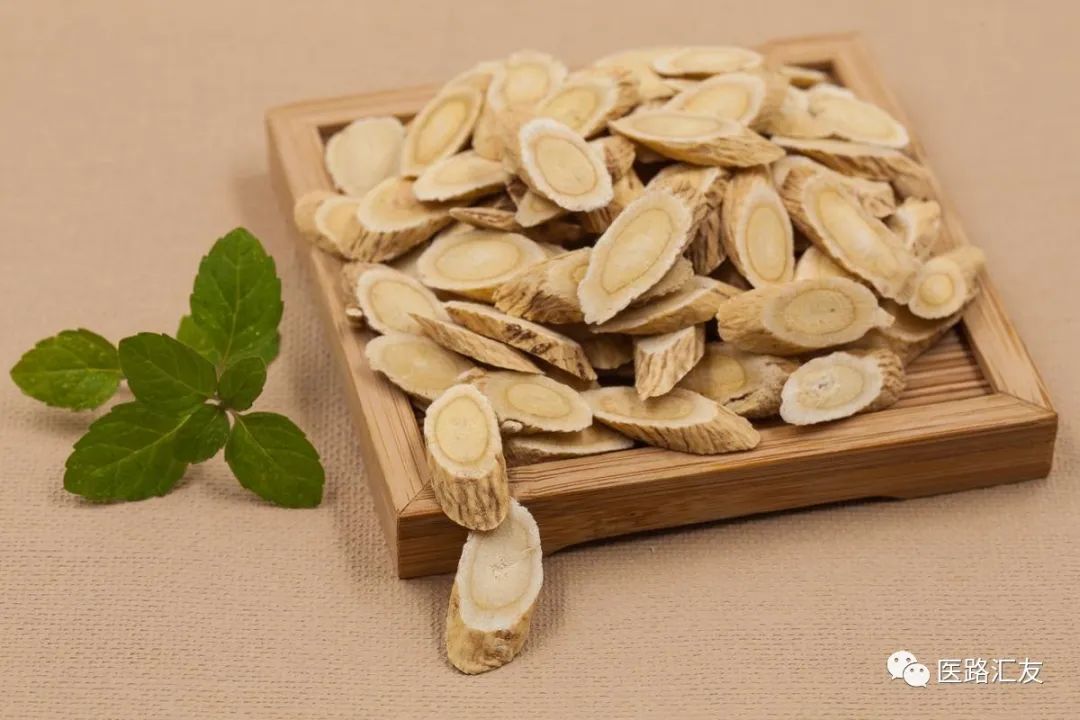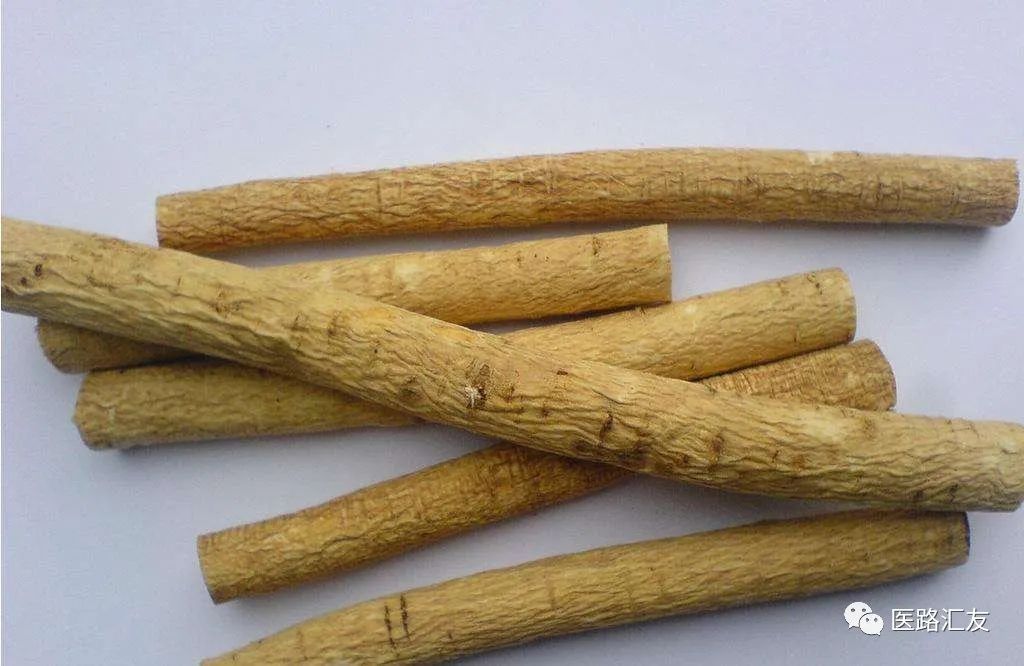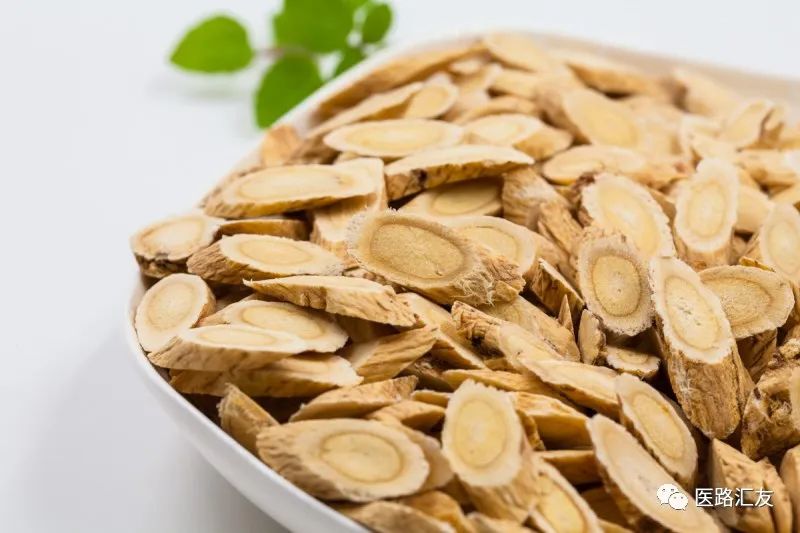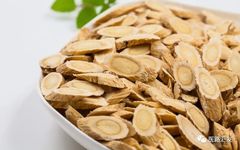
Huang Qi (Astragalus), a traditional Chinese medicinal herb, is the root of the leguminous plant Huang Qi (Astragalus membranaceus). It is harvested in spring and autumn, with the soil, fibrous roots, and root tips removed, then sun-dried until 60-70% dry, bundled, and further dried. Its functions and indications include: tonifying Qi and stabilizing the exterior, expelling toxins and promoting pus discharge, diuresis, and promoting tissue regeneration. It is used for conditions such as Qi deficiency, fatigue, chronic diarrhea, prolapse of the rectum, spontaneous sweating, edema, uterine prolapse, chronic nephritis with proteinuria, diabetes, and non-healing sores.
1、Part Used:
The root of the leguminous plant Huang Qi (Astragalus membranaceus). Harvested in spring and autumn, with the soil, fibrous roots, and root tips removed, then sun-dried until 60-70% dry, bundled, and further dried.
2、Properties and Channels:
Sweet in flavor, slightly warm in nature; enters the Spleen and Lung channels.
3、Functions and Indications:
Tonifies Qi and stabilizes the exterior, expels toxins and promotes pus discharge, diuresis, and promotes tissue regeneration. It is used for Qi deficiency, fatigue, chronic diarrhea, prolapse of the rectum, spontaneous sweating, edema, uterine prolapse, chronic nephritis with proteinuria, diabetes, and non-healing sores. It nourishes fluids and blood, promotes circulation, expels toxins, and promotes tissue regeneration. It belongs to the category of Qi tonics in the category of tonifying herbs.
4、Morphological Characteristics:
A perennial herb. The stem is erect, with branches in the upper part. The odd-pinnate compound leaves are alternate, with 12-18 pairs of leaflets; the leaflets are broadly oval or oval-shaped, with soft hairs on the underside; stipules are lanceolate. The racemose inflorescence is axillary; the calyx is bell-shaped, densely covered with short soft hairs, with 5 lobes; the corolla is yellow, with the banner petal being long oval-shaped, and the wing and keel petals both having long claws; there are 10 stamens, in two groups; the ovary has a long stalk. The pod is membranous, semi-oval, and hairless. The flowering period is from June to July, and the fruiting period is from July to September.
5、【Clinical Applications】Dosage is 9-30 grams, decocted for internal use; or used in pills, powders, or ointments. It treats shortness of breath, palpitations, fatigue, collapse, spontaneous sweating, night sweats, physical weakness with edema, chronic nephritis, chronic diarrhea, rectal prolapse, uterine prolapse, difficult-to-heal sores, pediatric bronchial asthma, chronic hepatitis B, chronic nephritis, and viral myocarditis. For Qi tonification, it is best used roasted; for stopping sweating, diuresis, expelling toxins, and promoting tissue regeneration, it is best used raw.
6、【Pharmacological Research】Huang Qi promotes nucleic acid metabolism; enhances hematopoietic function; improves myocardial function; counteracts myocardial infarction; has antioxidant, antiviral, anticancer properties, and improves kidney function and pathological changes in kidney tissue. The decoction has immune-regulating, anti-aging, and anti-stress effects. Toxicity: The LD50 of the decoction is (40±5) grams/kilogram.
7、Distribution:
Mainly produced in Inner Mongolia, Shanxi, and Heilongjiang; now widely cultivated.
8、Growing Environment:
Grows in sunny grasslands and hillsides.
9、Herb Characteristics:
The root is cylindrical, some branched, thicker at the top, slightly twisted, 30-90 cm long, and 0.7-3.5 cm in diameter. The surface is light brown to light brownish-yellow, with irregular longitudinal wrinkles and transverse lenticels; the cork easily peels off, exposing the yellow-white cortex, with some visible reticular fiber bundles. The texture is tough, with a strong fibrous fracture. It has a slight odor, a slightly sweet taste, and a bean-like flavor.

10、Related Combinations:
(1) For urinary obstruction: Use 6 grams of Huang Qi, add 2 bowls of water, decoct to 1 bowl, and take warm. For children, reduce the dosage by half.
(2) For jaundice due to alcohol (feeling cold after drinking, with red, black, or yellow spots on the body): Use 60 grams of Huang Qi and 30 grams of Magnolia, grind finely. Take a small amount each time, three times a day, with wine.
For leukorrhea: Use 15 grams of Huang Qi roasted with salt and 30 grams of Poria, grind finely. Take 3 grams each time.
(3) For atrophy and thirst (accompanied by the occurrence of sores): Use 180 grams of Huang Qi, half roasted, half steamed with salt water; also use 30 grams of Licorice, half raw, half roasted. Grind both herbs finely. Take 6 grams each time, twice a day. It can also be decocted. This formula is called “Huang Qi Liu Yi Decoction”.
(4) For constipation in the elderly: Use 15 grams each of Huang Qi and Chen Pi, grind finely. Also use 1 handful of hemp seeds, crush, add water to extract the juice, decoct until half dry, mix in 1 spoon of honey, and then boil again, adding the powdered Huang Qi and Chen Pi to mix well and take. Two doses can relieve constipation. It can be taken regularly.
(5) For blood lin: Use equal parts of Huang Qi and Huang Lian, grind into powder, and make into pills the size of mung beans. Take 30 pills each time.
(6) For less urination: Use equal parts of Huang Qi and Ren Shen, grind into powder. Also use 4-5 slices of radish, add 60 grams of honey, slightly roasted, and dip in the powdered herbs to eat, taking with salt water.
(7) For hemoptysis: Use 15 grams of Huang Qi and 25 grams of Purple Back Floating Duckweed, grind into powder. Take 3 grams each time, with ginger honey water.
(8) For coughing up pus and blood, with dry throat (this is due to deficiency heat, avoid cool herbs): Use 120 grams of Huang Qi and 30 grams of Licorice, grind into powder. Take 6 grams each time, with hot water.
(9) For lung abscess: Use 60 grams of Huang Qi, grind finely, and take 6 grams decocted. Can be taken three to four times a day.
(10) For toe abscess (red flesh protruding at the edge of the toenail): Use 60 grams of Huang Qi and 30 grams of Rehmannia, soak in vinegar overnight, add 250 grams of lard, simmer on low heat until reduced to 100 grams. Strain and apply the fat to the sore three times a day.
(11) For fetal movement discomfort (abdominal pain with yellow discharge): Use 30 grams each of Huang Qi and Chuan Xiong, 30 grams of glutinous rice, and 1 liter of water, cook until half done. Take in portions.
(12) For damp itching: Use Huang Qi roasted in wine, grind finely, and eat with cooked pig heart, effective.

11、Related Literature:
① For treating exterior deficiency with spontaneous sweating: Fang Feng 30 grams, Huang Qi (honey-roasted) and Bai Zhu each 60 grams. Take 9 grams each time, with 1.5 cups of water, add 1 date, decoct until 70% done, strain, and take warm after meals: (from “Yifang Leiju” citing “Jiuyuan Fang” Yu Ping Feng San)
② For treating Qi deficiency with weak Yang, persistent sweating, and fatigue: Huang Qi (remove the fibrous roots, honey-roasted) and Fu Zi (processed, remove skin and navel) in equal parts. Take 12 grams each time, with 2 cups of water, add slices of Sheng Jiang, decoct until 80% done, strain, and take warm before meals, at any time: (from “Yan Shi Ji Sheng Fang” Qi Fu Decoction)
③ For treating persistent hemoptysis: 7.5 grams of Huang Qi and 15 grams of Purple Back Floating Duckweed. Grind into powder. Take 3 grams each time, with ginger honey water: (from “Sheng Ji Zong Lu”)
④ For treating intestinal wind with blood in stool: equal parts of Huang Qi and Huang Lian. Grind into powder, make into pills the size of green beans. Take 30 pills, with rice drink: (from “Chuan Jia Mi Bao”)
⑤ For treating blood in urine, painful and unbearable: equal parts of Huang Qi and Ren Shen. Grind into powder, use one large radish, cut into 4-5 thick slices, add 60 grams of honey, soak and roast until done, without burning, dip in the powder. Take at any time, with salt water: (from “Yong Lei Qian Fang”)
【Contraindications】: For those with exterior excess, damp obstruction, gastrointestinal accumulation, Yin deficiency with Yang excess, or in the early stages of sores or after they have burst with heat toxin, it is contraindicated.
Promoting Traditional Chinese Medicine Culture
Disseminating Traditional Chinese Medicine Knowledge


